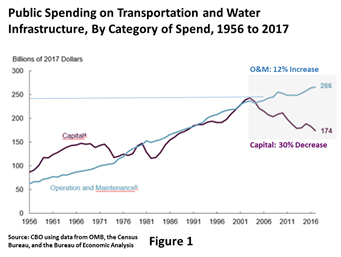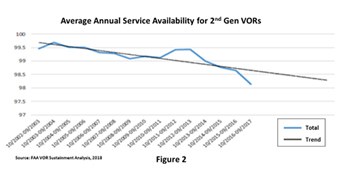Ground-Based Navigation Aids, known as NAVAIDs, are critical to the U.S. transportation infrastructure. The flying public and military depends on the safety and reliability of this infrastructure. The FAA’s NAVAIDs are some of the oldest in the world. Here is the different systems provide navigation to pilots.
Investment in the nation’s infrastructure over the last 15+ years has shifted toward an alarming and unsustainable trend: capital improvements have declined (-30%), while operations and maintenance costs have risen (+12%) in inflation adjusted dollars. See Figure 1.
Due in part to this lack of re-investment, many legacy ground-based Air Traffic Control (ATC) systems are now well beyond their planned life expectancy. This includes the FAA’s network of over 2,700 navigation and landing systems located at over 1500 sites in all 50 states. Most of these systems were installed in the 1980’s, and are well past their intended service life.
These systems are essential elements for air traffic operations and have been mandated by FAA for use through at least 2045 to ensure safety, robustness, and resiliency.
Why is it Urgent?
The FAA has recognized the issue, and planning is already underway to replace these aging systems. However, the pace of this activity is well below the threshold required – at current funding levels, it will take more than 100 years to modernize this infrastructure. It is important to understand that old electronic equipment is not sustainable indefinitely.
Accelerating rates of component failures combined with parts obsolescence creates the risk of a cascade of field failures that will endanger NAS safety and affect the flying public.
A recent FAA sustainment study clearly indicates that the availability of these 35+ year-old ATC systems is well below their required performance levels, and trending in the wrong direction. See Figure 2.


